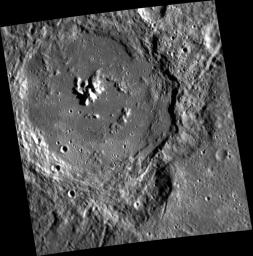We begin the New Year with an introduction to some of the newly named craters on Mercury. Had you been celebrating the New Year at the turn of the 19th century, you might have danced the night away to the music of Joplin crater's namesake. Scott Joplin (1868-1917) composed some of the best-known ragtime pieces, including iconic works like "The Entertainer." This high-resolution observation of Joplin crater reveals a partial peak ring as well as a more prominent cluster of larger central peaks.
This image was acquired as part of MDIS's high-resolution stereo imaging campaign. Images from the stereo imaging campaign are used in combination with the surface morphology base map or the albedo base map to create high-resolution stereo views of Mercury's surface, with an average resolution of 200 meters/pixel. Viewing the surface under the same Sun illumination conditions but from two or more viewing angles enables information about the small-scale topography of Mercury's surface to be obtained.
Date acquired: January 16, 2012
Image Mission Elapsed Time (MET): 235169452
Image ID: 1271337
Instrument: Narrow Angle Camera (NAC) of the Mercury Dual Imaging System (MDIS)
Center Latitude: -38.87°
Center Longitude: 26.48° E
Resolution: 176 meters/pixel
Scale: Joplin crater is 138.98 kilometers (86.58 miles) in diameter
Incidence Angle: 75.2°
Emission Angle: 21.6°
Phase Angle: 80.3°
The MESSENGER spacecraft is the first ever to orbit the planet Mercury, and the spacecraft's seven scientific instruments and radio science investigation are unraveling the history and evolution of the Solar System's innermost planet. Visit the Why Mercury? section of this website to learn more about the key science questions that the MESSENGER mission is addressing. During the one-year primary mission, MDIS acquired 88,746 images and extensive other data sets. MESSENGER is now in a year-long extended mission, during which plans call for the acquisition of more than 80,000 additional images to support MESSENGER's science goals.
For information regarding the use of images, see the MESSENGER image use policy.

 Planetary Data System
Planetary Data System












